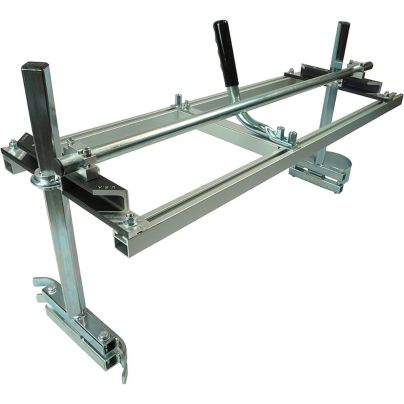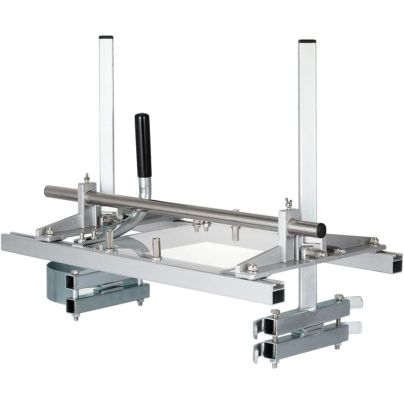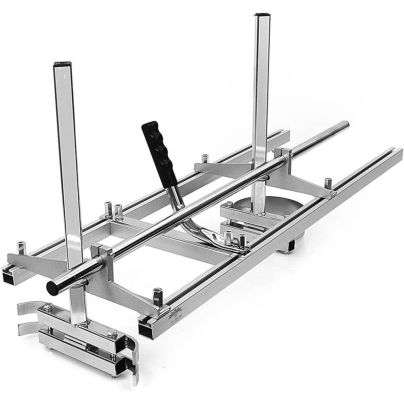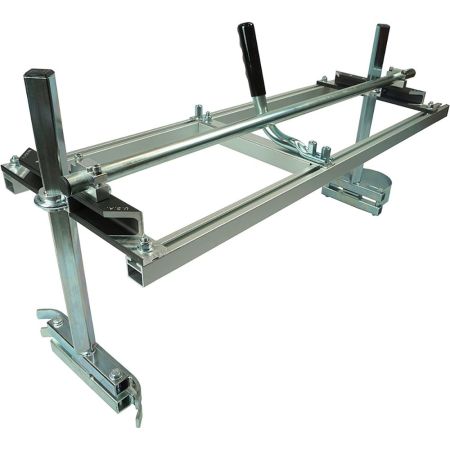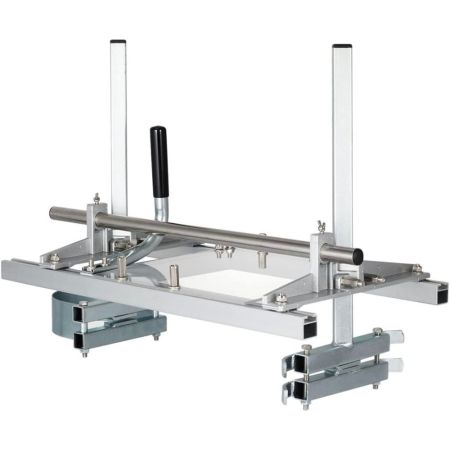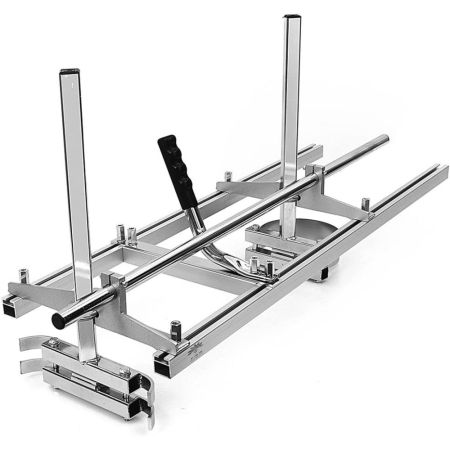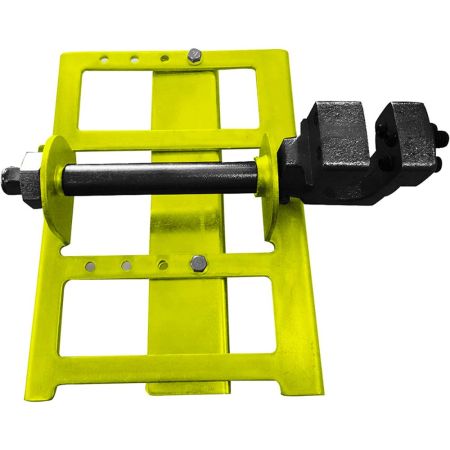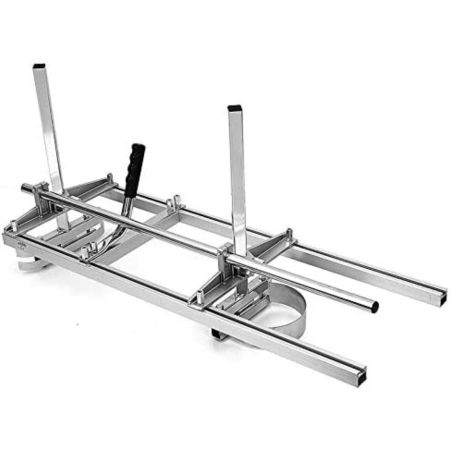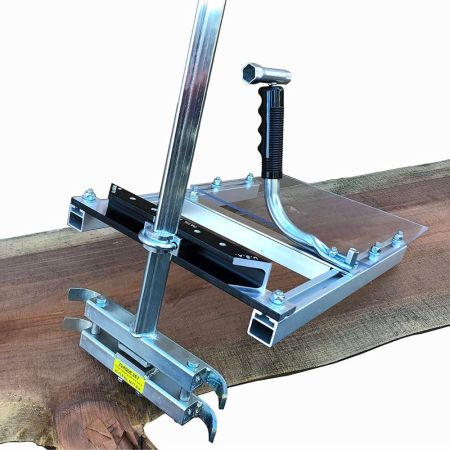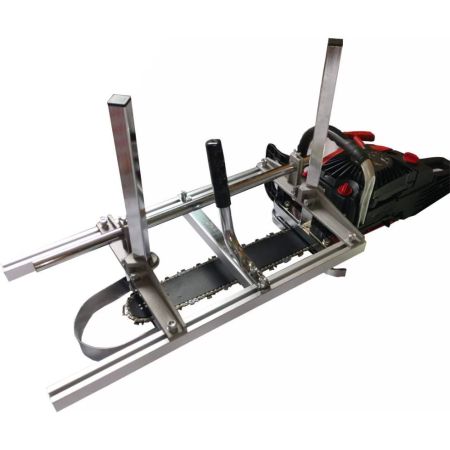We may earn revenue from the products available on this page and participate in affiliate programs. Learn More ›
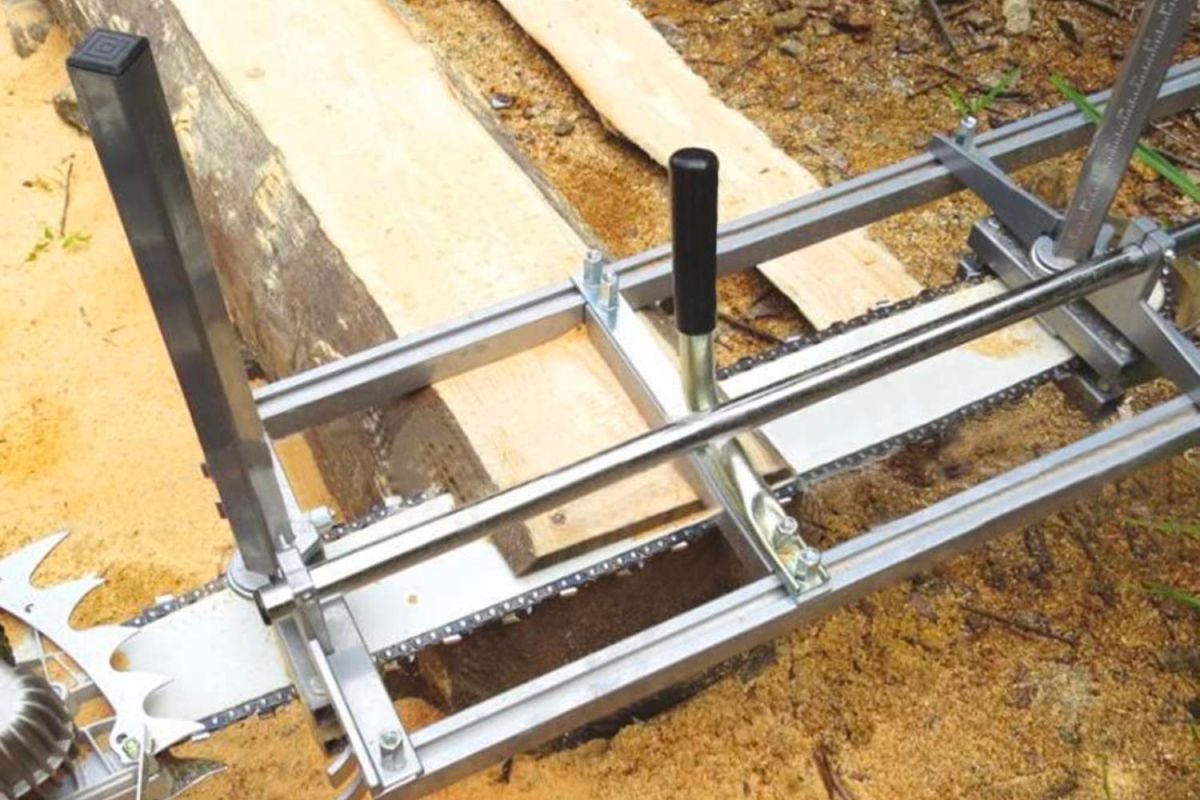
Store-bought lumber is expensive, and it can vary in quality considerably. For those who have access to a supply of logs, DIY chainsaw milling will almost certainly help save money. It also provides complete control over beam and board sizes and allows for close monitoring of quality.
Chainsaw mills provide a versatile, portable, easy-to-use solution. Many mills are also very affordable, particularly for those who already own a suitable chainsaw for felling or cutting firewood. That said, chainsaw mills aren’t particularly common tools, so many people don’t understand which features are important.
This guide not only offers some helpful tips and suggestions but also takes a detailed look at some of the best chainsaw mills available. In-depth market analysis and thorough product vetting went into creating this list of top picks.
- BEST OVERALL: Granberg G778 36-Inch Alaskan MKIV Chainsaw Mill
- BEST BANG FOR THE BUCK: HiHydro 36-Inch Portable Chainsaw Mill
- BEST COMPACT: Carmyra 24-Inch Portable Chainsaw Mill
- BEST FOR BEGINNERS: Timber Tuff TMW-56 Lumber Cutting Guide
- BEST HEAVY-DUTY: Carmyra 48-Inch Chainsaw Mill
- HONORABLE MENTION: Granberg G777 Alaskan Small Log Mill
- ALSO CONSIDER: XRKJ 36-Inch Chainsaw Mill
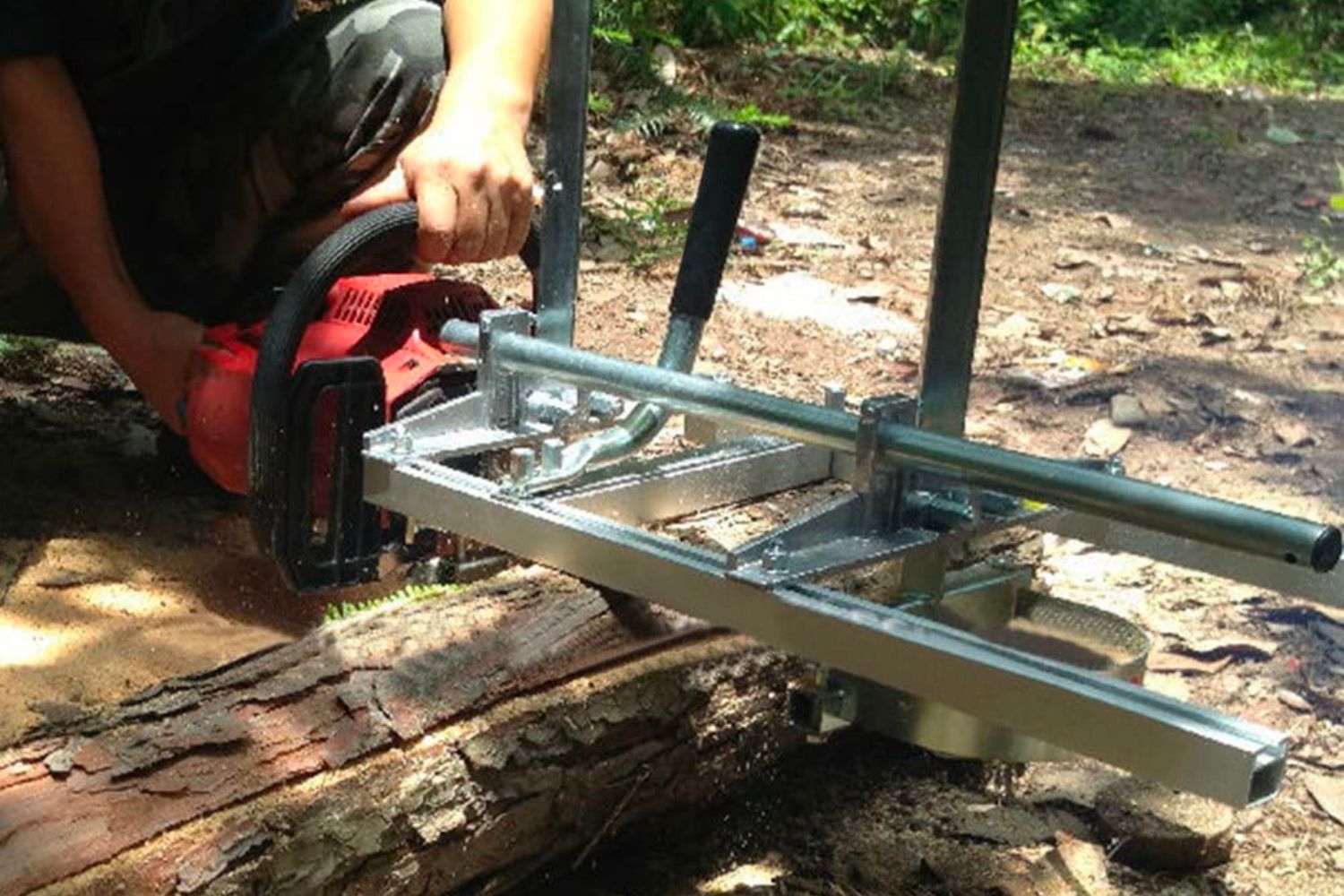
How We Chose the Best Chainsaw Mills
As the owner of a large property, I have considerable experience with chainsaws. I am also an engineer by profession, so I have a good understanding of the structure and function of chainsaw mills. When selecting our top picks, I used the following criteria:
- Build quality: Chainsaw mills aren’t likely to be treated with a great deal of care, so a primary concern is how well they’re assembled. Each of the models chosen has the strength and durability to withstand a tough working environment.
- Brand: Many of our choices come from brands that have extended experience in the field and a recognized reputation. However, these units can come at a premium price, so I’ve also considered well-made tools from lesser-known manufacturers.
- Value: Most chainsaw mills are very affordable, particularly when weighing the potential savings over store-bought lumber. Nevertheless, we were careful to pick models with a range of prices to offer something for every budget.
Our Top Picks
Now, let’s apply this selection criteria to determining the best chainsaw mills currently available. Keep reading to learn more about some of the best chainsaw mills on today’s market.
Best Overall
Granberg G778 36-Inch Alaskan MKIV Chainsaw Mill
See ItThe Granberg Alaskan MKIV chainsaw mill takes top honors for its build quality, ease of use, and versatile functionality.
The sturdy construction combines heavy-duty zinc-plated steel and aircraft-grade aluminum. It takes around 30 minutes to assemble, but once assembled, clamping and adjustment are fast thanks to clearly marked depth scales. At only 20 pounds, it’s portable too.
The Granberg Alaskan MKIV chainsaw mill is designed to take a maximum 36-inch chainsaw, and the manufacturer recommends a motor capacity of 70 cubic centimeters (cc) or better. It can take smaller chainsaws, but if working with a smaller chainsaw, consider a lower-cost mill—the Granberg isn’t cheap. The bar clamp takes 3 to 4 inches from the cutting capacity, so using a 20-inch bar, for example, restricts the cut to around 16 inches.
Product Specs
- Bar size: 20 inches to 36 inches
- Cutting capacity: ½ inch to 13 inches thick; 32 inches wide
- Weight: 20 pounds
Pros
- A high-quality tool made in the United States that consistently tops independent reviews
- An excellent midrange model recognized for its consistent accuracy and renowned durability
- Can be set up for both left- and right-handed users
Cons
- Comes with a higher sticker price than many similarly sized competitors
- Assembly takes around 30 minutes, which some buyers found frustrating
Get the Granberg G778 chainsaw mill at Amazon, Northern Tool + Equipment, or Acme Tools.
Best Bang for the Buck
HiHydro 36-Inch Portable Chainsaw Mill
See ItWith a well-proven design constructed from high-quality steel and aluminum, the HiHydro is a premium chainsaw mill at a budget price. Unfortunately, the instructions are only fair, so assembling the mill can be frustrating. However, once put together, it has competitive capacities and should prove durable.
HiHydro claims a cutting width of 36 inches, but as with many competitors, this measurement doesn’t consider the clamp. While these always reduce capacity a bit, on the HiHydro, the loss is around 5 inches—fairly significant. Although the mill can take chainsaws as small as 14 inches, that only leaves a 9-inch cut, which is seldom practical. With this model, experts advise using a 30-inch or longer saw, which makes this an affordable option.
Product Specs
- Bar size: 14 inches to 36 inches
- Cutting capacity: ½ inch to 13 inches thick; 31 inches wide
- Weight: 8 pounds
Pros
- Uses a well-proven design and provides good value for money
- Aluminum and rust-resistant galvanized steel should result in good durability
- Light weight makes it equally convenient for home or on-site use
Cons
- While it is not difficult to assemble, many feel the instructions are poor
- A number of buyers have reported their packages had nuts and bolts missing
Get the HiHydro chainsaw mill at Amazon.
Best Compact
Carmyra 24-Inch Portable Chainsaw Mill
See ItThe Carmyra chainsaw mill uses the same popular and effective design as many competitors. The manufacturer uses a combination of steel and aluminum, resulting in a good balance between strength and portability.
This 24-inch model is particularly suitable for those who only need to mill small to medium-size logs. As is common, the clamp reduces the overall cutting width, in this case by approximately 4.5 inches. This results in a maximum cut of little more than 18 inches. While it’s smaller than many competitors, the Carmyra still produces planks that are useful for a wide variety of projects. For those who mill lumber infrequently or need relatively low lumber volumes, the 24-inch Carmyra is a good choice at a competitive price.
Product Specs
- Bar size: 14 inches to 24 inches
- Cutting capacity: ½ inch to 13 inches thick; 18½ inches wide
- Weight: 13 pounds
Pros
- Compact dimensions are ideal for many DIY users with smaller chainsaws
- Despite the relatively small size, it is capable of producing useful 18-inch wide boards
- Competitive price makes it a popular choice with low-volume users
Cons
- Many feel that instructions are poor (though helpful videos are available)
- Although welding or component failures are rare, they have happened
Get the Carmyra 24-inch chainsaw mill at Amazon.
Best for Beginners
Timber Tuff TMW-56 Lumber Cutting Guide
See ItThe Timber Tuff TMW-56 is called a cutting guide rather than a chainsaw mill because it operates slightly differently. Nevertheless, it produces similar results, and its cutting capacity is limited only by the size of the chainsaw used.
The heavy-duty steel guide is designed to run along a piece of store-bought lumber, such as a 2×2, 2×4, or 2×6. The user simply nails or screws the store-bought board to a log, bolts the chainsaw bar to the Timber Tuff, and runs the guide along the board. Cutting widths are defined by where users position the board for each cut.
While setting up each cut takes a little more time and care than other types of chainsaw mills, it is light, simple, effective, and comes at a very low cost.
Product Specs
- Bar size: Any
- Cutting capacity: See description
- Weight: 3½ pounds
Pros
- Made from heavy-duty steel and powder coated to resist corrosion
- Easy to use with standard store-bought lumber as a guide
- Costs considerably less than most competitors and can accept any size chainsaw
Cons
- With no preset depth guide, each cut takes a few minutes to set up
- Slow operation means it is not suited to high-productivity environments
Get the Timber Tuff chainsaw mill at Amazon, Lowe’s, Tractor Supply Co., Target, or Grainger.
Best Heavy-Duty
Carmyra 48-Inch Chainsaw Mill
See ItThose needing to saw large logs will want to take a closer look at this 48-inch Carmyra chainsaw mill. Even with some width loss due to the clamping mechanism, it can still saw boards up to an impressive 43½ inches wide. Like its smaller counterparts, it also has the versatility to mill thicknesses from just ½ inch up to 13 inches.
The design is popular and well proven. It uses a combination of steel for toughness and durability with aluminum to keep the weight manageable. Despite the heavy-duty nature of this chainsaw mill, it weighs only 16½ pounds.
Although rated for chainsaws as small as 14 inches, some bars are too narrow to accommodate the clamp. However, in reality, those with small chainsaws have no need for a mill this large.
Product Specs
- Bar size: 14 inches to 48 inches
- Cutting capacity: ½ inch to 13 inches thick; 43½ inches wide
- Weight: 16½ pounds
Pros
- Made from steel and aluminum, so it’s strong but manageable
- A well-proven design scaled up for heavy-duty milling capacities
- Capable of high productivity in hard-working environments yet remains very competitively priced
Cons
- Instructions are poor, and there are several reports of missing parts
- Will not fit some small chainsaws, notably Craftsman 16-inch models
Get the Carmyra 48-inch chainsaw mill at Amazon.
Honorable Mention
Granberg G777 Alaskan Small Log Mill
See ItGranberg classifies its G777 as a small-log chainsaw mill. While capacities aren’t equal to the Alaskan MKIV, the G777 is a quality tool that offers versatility in cutting depth. It’s also more compact and lighter than the Alaskan MKIV, making it ideal for field use when more modest log sizes are available.
The G777 tracks across the board’s surface like other horizontal mills, but it’s only supported on one side. As a result, users should take care when setting up the first cut. Subsequent cuts also require focus to maintain accuracy, though most users should acclimate to the tool quickly.
Product Specs
- Bar size: 16 inches to 20 inches
- Cutting capacity: ½ inch to 13 inches thick; 18 inches wide
- Weight: 10 pounds
Pros
- A compact mill from a brand known for quality and durability
- Lightweight and portable, making it ideal for milling in the field
- Improved end brackets are stronger, easier to adjust, and more accurate
Cons
- Single-sided design lacks the stability of models with twin supports
- It is important to make the first cut carefully, as this impacts subsequent boards
Get the Granberg G777 chainsaw mill at Amazon, Northern Tool + Equipment, or Acme Tools.
Also Consider
XRKJ 36-Inch Chainsaw Mill
See ItFeaturing a similar design to the Granberg Alaskan MKIV, the XRKJ is a low-cost horizontal chainsaw mill that’s constructed from quality materials. For the occasional user, it also offers good value for the money.
Steel and aluminum construction means that it’s not only strong but also lightweight. Unfortunately, build quality seems to vary, which might make assembly frustrating. Although the minimum bar size is listed as 12 inches, the resulting maximum cut is only around 8 inches. Additionally, chainsaws of that size are unlikely to provide sufficient power, so a 20-inch chainsaw is the smallest practical size.
Product Specs
- Bar size: 12 inches to 36 inches
- Cutting capacity: ½ inch to 13 inches thick; 32 inches wide
- Weight: 16 pounds
Pros
- A very affordable chainsaw mill that employs a well-proven design
- Offers competitive capacities and takes a wide range of chainsaw sizes
- A good choice for the user who is milling lumber infrequently
Cons
- Despite the capacity, this mill is not intended for regular, heavy-duty use
- Feedback from buyers tells us that build quality can vary considerably
Get the XRKJ chainsaw mill at Amazon.
Jump to Our Top Picks
What to Consider When Choosing a Chainsaw Mill
A chainsaw mill (also called a “chainsaw sawmill” or “Alaskan sawmill”) isn’t a particularly complicated device. However, chainsaw mills possess a number of key features that differentiate them, which has a big impact on choice.
Chainsaw Compatibility
Chainsaw mill compatibility can be considered in two ways: in terms of power requirement or whether a particular make or model of chainsaw will fit the device.
Cutting planks with a chainsaw mill requires a saw with considerable power. While a few cordless chainsaws offer comparable performance for tree felling or log cutting, milling takes a lot of energy and soon drains the battery. The challenge with even the best corded electric chainsaws is overheating. While a safety cutout usually prevents damage to the saw, it makes them impractical for milling.
That leaves gas-powered chainsaws as the only sensible choice. When describing compatibility with a chainsaw, chainsaw mill manufacturers often describe their tools as fitting “most types of chainsaw.” However, restrictions exist in bar length, so a minimum engine displacement (defined in cubic centimeters) is suggested. While some mills clamp the chainsaw bar, a few require it to be drilled to affix it, something many users would rather avoid.
Bar Capacity and Cutting Depth
Chainsaws are usually described by their bar length: 16 inches, 24 inches, etc. When considering chainsaw mills, bar size has a major impact on the maximum diameter of log that can be milled and, thus, the width of plank produced.
However, the stated dimensions can sometimes be misleading. If the mill clamps the bar end, as many do, it reduces the length available for cutting. While bar size is important for fitting the chainsaw to the mill, users will also want to check the mill’s cut size to determine its actual capacity.
Cutting depth is another key feature, and it depends on the type of chainsaw mill chosen. Some cut with the chainsaw held vertically (often called “edging mills”). These offer unlimited versatility, but repeatable accuracy is more challenging. Other mills cut with the chainsaw mounted horizontally, which can be set to a consistent thickness. Most run from ½ inch to 12 inches, though cuts as thin as ⅕ inch are possible. Some large-capacity models can exceed 15 inches.
Ease of Use
Small chainsaw mills frequently arrive ready to go right out of the box, but larger models generally require some assembly. Hardware is invariably included, and the tools may be, but the user may need to grab a couple of wrenches. These chainsaw mills are not complicated devices, but the quality of their instructions varies.
As mentioned, most chainsaw mills clamp the chainsaw bar. Some require drilling, which entails extra work. It’s probably best to avoid those models, as many options exist that don’t require drilling.
Chainsaw mills fall into two categories: edging mills and horizontal mills. Edging mills must be run on a board mounted to the log, and they’re generally used for squaring up logs for building purposes rather than for cutting multiple planks. Horizontal mills rest on top of the log and cut consistent plank thicknesses. Adjustment is usually straightforward via a couple of bolts.
Portability and Durability
One of the biggest advantages of a chainsaw mill is portability. They often weigh just 4 or 5 pounds; even the larger horizontal models seldom go over 20 pounds. Because they’re so lightweight, users can easily take the mill to the felled tree and work on-site. With only the cut lumber to move, a trailer or pickup truck often is sufficient to transfer the wood.
Construction materials are typically a mix of steel and aluminum. Steel offers great strength, so it’s used for the main structural components that hold things together. Chainsaw mills are often electroplated (usually with zinc, nickel, or chrome) to protect against rust. Aluminum is much lighter, so it’s generally used for guide rails. Look for a rugged build with consistent welds and metal with substantial thickness or cross section.
How to Use a Chainsaw Mill
Chainsaw mills are a reasonably simple tool to use, but always follow basic safety precautions. Also, take a couple of important steps when setting up the mill to ensure consistent, quality results.
- Ensure the log to be cut is stable. Use chocks underneath to prevent any chance of it rolling.
- Follow general chainsaw safety rules. Wear substantial footwear, gloves, a face shield, and ear protection. Chainsaw chaps are also a good idea.
- Check that the chainsaw chain is sharp. A blunt chain is not simply inefficient—it’s also more likely to bind or jump off the bar.
- The first cut is key. Used by itself, the mill rests on uneven bark and trimmed branches, which means making a clean, even cut is almost impossible. To remove that rough surface, some kind of guide is necessary.
- Edge mills usually run along a length of shop-bought or precut board that’s screwed to the log.
- For horizontal mills, a jig is affixed to the log. Some people rig up an ordinary aluminum ladder, but getting it level can be challenging. Purpose-built jigs are available that are much easier to adjust.
- Once the outer layer is removed, horizontal mills can rest on the now-flat surface. It’s not a complicated process, but users will want to take care when making the initial cut. It provides the surface for each consecutive cut.
FAQs
The sections above offer an in-depth look at the technical aspects of chainsaw mills, followed by real-world examples. Together, they give the mill buyer extensive information on the subject. However, in researching this article, a number of questions came up that benefit from separate answers.
Q. Should I purchase a chainsaw mill or a band sawmill?
If you’re looking for an affordable, easily portable tool for sawing a modest number of logs per year, the chainsaw mill is probably the better choice, especially if you already own a suitable chainsaw. A bandsaw mill offers higher productivity and less waste, but most are a lot more expensive. They are more likely to appeal to those who are milling logs commercially.
Q. What’s the best size chainsaw to use with a chainsaw mill?
Each chainsaw mill has a maximum size chainsaw that will fit it. As this is one of those occasions when you can never have too much power, experts recommend using the biggest chainsaw possible within the specifications of the chosen mill.
Q. If I have a smaller bar, can I still use a larger mill?
Often you can, but it depends on the mill. Most chainsaw mills offer a degree of versatility; however, it’s important to check the minimum size. Usually, this is around 14 inches. That said, a chainsaw with a bar that short might not have the necessary power to cut effectively. Also, remember that a smaller bar length restricts the size of logs you can cut.
Q. How big of a chainsaw do I need for an Alaskan mill?
There are numerous models of Alaskan mills, ranging from the smallest, which can take a 12-inch chainsaw, to the largest, which can use a 60-inch chainsaw. It is important not to underestimate your needs. Choose a chainsaw that will comfortably cut the diameter of logs you use regularly. Remember that clamping the chainsaw bar will usually reduce the usable length by 3 or 4 inches.
Q. How long does it take to cut planks with a chainsaw mill?
Chainsaw milling is not a fast process. A lot depends on the log size and material density. Pine, for example, is easier to saw than oak. Knots or twisted grain will have an impact, as will the chain’s sharpness and power. With so many variables, it’s difficult to be precise, though most experts suggest between 10 and 20 minutes per cut as an average.
Q. How much power is necessary for a saw?
When it comes to chainsaw mill work, it is undoubtedly a case of the more power, the better. This is both for cutting speed and minimizing the stress on the chainsaw motor. Experts suggest a 50cc gas chainsaw as an absolute minimum, though 70cc and above is normally recommended. Granberg, for example, the manufacturer of our overall best chainsaw mill, suggests 70cc or bigger for their tool.
Q. What is a ripping chain?
A standard chainsaw chain is designed to cut across the tree trunk for felling or cutting logs for firewood. Effectively, this means you’re cutting across the grain. A ripping chain is designed to cut with the grain along the length of the trunk, so it’s better when using a chainsaw mill.
Q. What are a chainsaw mill’s limitations?
Each chainsaw mill has a maximum depth of cut and maximum width. How the mill clamps the chainsaw blade has an impact, so check the chainsaw mill’s specifications carefully.
Why Trust Bob Vila
Bob Vila has been America’s Handyman since 1979. As the host of beloved and groundbreaking TV series including “This Old House” and “Bob Vila’s Home Again,” he popularized and became synonymous with “do-it-yourself” home improvement.
Over the course of his decades-long career, Bob Vila has helped millions of people build, renovate, repair, and live better each day—a tradition that continues today with expert yet accessible home advice. The Bob Vila team distills need-to-know information into project tutorials, maintenance guides, tool 101s, and more. These home and garden experts then thoroughly research, vet, and recommend products that support homeowners, renters, DIYers, and professionals in their to-do lists.
